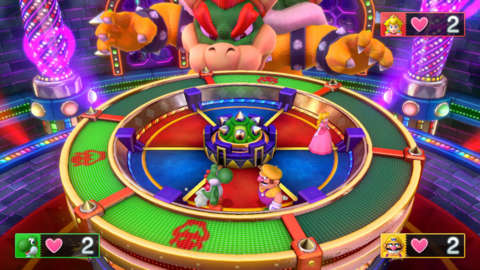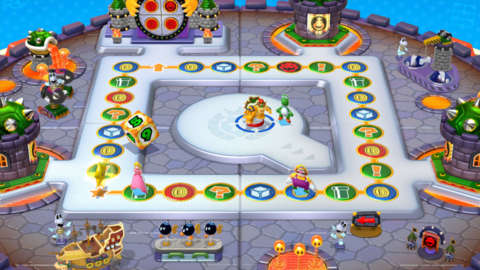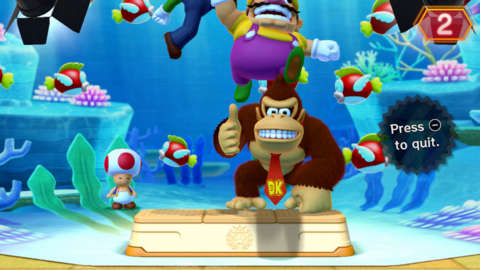Ah, Mario Party, the game that, on paper at least, should be a rollicking good time filled with joyful minigames and all your favourite Nintendo characters. It's hard not be suckered in by that classic Nintendo charm, the bright colours, the jangly music, Mario yelling "it's-a-me!" If games were fun based on nostalgia value alone, then Mario Party 10 would be a wonderful creation. But they're not, and once you're over the sight of Mario and friends riding along in a Boo-inspired ghost train, the game's mildly amusing take on a family board game wears thin.
That's not to say there isn't some fun to be had, particularly if you've got some good friends to play with--it's just that Mario Party 10 isn't the kind of game you'll want to dig out more than a couple of times a year. Part of the problem is that, like Mario Party 9, Mario Party 10 is essentially the same board game-inspired experience as it's always been. Granted, the move to the Wii U has opened up a few new ways to play via the wonder of the gamepad or a selected group of Amiibo, but these things are mere window dressing over Mario Party's otherwise unchanged core.


Let's start with the biggest change: the Amiibo integration. On the surface, getting some use out of Nintendo's cute plastic figures of joy is no bad thing, particularly as, up to this point, they've played a largely passive role in the games they've been compatible with. They play a much bigger role in Mario Party 10, but there are some limitations. For starters, only a very specific set of Amiibo do anything significant, with the rest relegated to a read-only capacity to earn Mario Party points that can be spent on items in the game.
Those Amiibo with full functionality can only be used in the specific Amiibo mode, which harks back to Mario Party games of old. Instead of a large board where all four players travel around in a vehicle together like in Mario Marty 9, the Amiibo mode makes use of a much smaller circular board, with each player fighting it out to collect the most stars across 10 rounds. Virtual dice rolls dictate how far you move around the board, while the squares that you land on dish out coins, bonuses, and minigames, or take away coins and set you back a few places. Depending on what Amiibo you use, the board takes on a different theme. Scan in Mario, and you get a board full of goombas and Mushroom powerups; scan in Donkey Kong, and the game brings up various jungle-based fripperies.
Each board has its own different ways of distributing powerups like slow dice and 4-5-6 dice to players. I particularly like the Mario board, which featured a set of ?-boxes, where finding the mushroom would grow your character and have it storm around the board stealing coins from other players. Amiibos are also able to carry around a special token with them that you find during your travels around the board. These do things like add more stars to the board, randomly dole out coins, or switch a section of the board out for another themed version from the likes of Peach and Yoshi.
This looks pretty neat, particularly if you manage to deck out each quarter of the board in a different theme. But it is mostly just looks. There's little strategic value to swapping out the boards, each merely serving as a slightly different way to dish out the same set of powerups. What does change things up is how you collect stars. Instead of being given stars as you work your way around the board, you have to collect coins by landing on certain squares. 20 coins net you one star, but you can only trade those coins in when you find a square on the board with a star floating above it. If you land on the square and you don't have 20 coins, you're out of luck.
With the stars moving randomly around the board after each round, items like warp pipes or special dice that can move you backwards become incredibly valuable. Indeed, this system is one of the few things in Mario Party that gives you some sort of strategic option to best the opposition, rather than simply relying on a roll of the dice. Amiibo mode is fun, and the quicker rounds make it a good option for those who'd rather not go through a full half-hour game. Still, it's hard to ignore that the Amiibo mode is essentially just a smaller version of a full-blown Mario Party. You might be travelling on your lonesome rather than together in a vehicle, but the end result is the same: roll the dice, move around the board, and collect as many stars as possible.


Naturally, there are some fun minigames to break up the action. They're played after each round in Amiibo mode, or when you land on a certain square Mario Party mode, which brings back the group vehicle travelling of Mario Party 9. For the most part, these games are easy to pick up, and instil the sort of aggressive, expletive-filled competition that one might not expect from such a family orientated game. Most of the minigames are a free-for-all (where every player competes against each other), and consist of a mixture of action-based platforming challenges and frantic motion-controlled games, and slower-paced memory games and pattern-recognition tests.
These include climbing up ladders and bouncing off the head of a giant goomba to score points, smashing as many leaping fish out of the air as possible, and (my personal favourite), having to pose in front of the camera while also slapping the other players out of the shot. There are some neat 2v2 challenges to play through too, including a Monkeyball-like soccer game played by tilting the Wii Remote. Ah, but "what about the Gamepad" I hear you cry! Yes, the gamepad plays a starring role in the new Bowser Party mode, or in Amiibo mode if you have a Bowser Amiibo to use.


Either way, one player takes on the role of Bowser, using the gamepad to play minigames against the other four players. While these minigames don't exactly make the game-changer Nintendo might have hoped for, they're actually pretty fun. Some of my favourites included a game where you tilt the gamepad to move fiery bars around while the other players have to jump around and avoid them, another that has you chasing players up a wall while they madly smash buttons Track and Field-style to escape, and another that's an evil version of roulette played with bombs and traps.
In Bowser Party, there are also sections where Bowser can attempt to deceive the other players by drawing doodles or placing stamps over different paths on the map or on mystery crates that may contain prizes or dangers. Weirdly, during these moments the game tells you to trick the other players via the main screen, which sort of defeats the object of the whole thing. But I suppose this way you're left questioning whether those doodles are a double bluff, or even a triple bluff. Despite all these additions, though, playing as Bowser is much less entertaining than playing at the other characters, mostly because there's far more waiting around, trying to catch up with the other players who get a head start.
It's only when you catch up with them that the minigames kick into action, and it's those that make up the bulk of Mario Party 10's entertainment value. There are at least quite a few of them on offer, and it's rare to see the same two minigames during a single round. However, like previous games in the series, Mario Party 10 is often more about luck than any skill you might have shown along the way. The game has an annoying habit of stealing stars away from whoever is in the lead, making any effort you've put into the minigames largely a moot point. Playing against friends is one thing, because you'll at least have someone to vent at, but against the AI, the game becomes very frustrating.
Despite the Amiibo additions and gamepad Bowser games, as well as a delightfully bright and colourful aesthetic, it's hard to ignore just how similar this game is to its predecessors. But even if you could overlook it, the fact remains that even with some fun minigames in tow and a good group of friends to enjoy it with, Mario Party 10 just doesn't have the depth or the challenge to hold your attention for long.